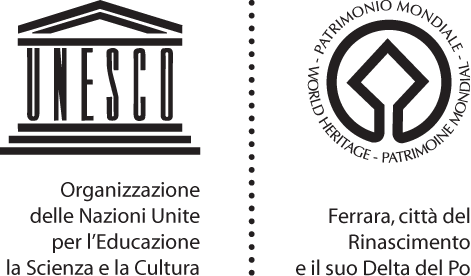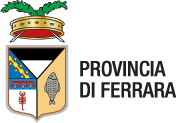Art and culture
Corso Ercole I d'Este
It was called Via degli Angeli after the church of St. Mary of the Angels that once rose at the end of it.
Corso Giovecca
This street, built by Biagio Rossetti by demolishing the old walls, forms the link between the Medioeval city to the south, and the Addizione Erculea to the north,...
Estense Castle
In Ferrara in 1385, a dangerous revolt convinced Niccolò II d’Este of the need to erect mighty defences for himself and his family thus the Castello di San Michele was built, a fortress erected against the people
Ferrara, town of the Renaissance and its Po Delta
UNESCO, the United Nations Education, Scientific and Cultural Organisation, included the territory around Ferrara in its lists on two separate occasions.
House of Ludovico Ariosto
The house, probably built to the design of Girolamo da Carpi, has a simple but elegant brick façade
Jewish cemetery
It is an evocative, silent place dominated by nature, which embraces and almost envelops the simple gravestones
Jewish Ghetto
In the heart of the medieval city lies the ghetto, an area which conserves the memories of the centuries-old Jewish Community of Ferrara and where the same community was from 1627 to 1861.
Lapidary Museum
The Lapidary Museum, housed in the ex-church of Santa Libera, has a rich collection of Roman works in marble from the province of Ferrara
MEIS Museo Nazionale dell'Ebraismo Italiano e della Shoah
At the National Museum of Italian Judaism and the Shoah are open the permanent exhibitions: "1938: HUMANITY DENIED" by Giovanni Grasso and Paco Lanciano and "Jews, an Italian history" to discover the history of Jews in Italy from the era of ancient Rome to the Renaissance.
Modern and Contemporary Art Gallery
The Modern and Contemporary Art Gallery houses important, prestigious temporary exhibitions organised in collaboration with Ferrara Arte,...
Monastery of Corpus Domini
It keeps the memories of Santa Caterina Vegri together with some tombs of the Este family: among them, the tomb of Lucrezia Borgia
Monastery of Sant'Antonio in Polesine
Set in the heart of the medieval city, the monastery still gives the sense of isolation and tranquillity it did during its early years, when it stood upon an island in the middle of the Po.
Museo del Risorgimento e della Resistenza
The Museum is closed to the public until further notice.
Museum of Casa Romei
CLOSED FOR RESTORATION from November 18th, 2024
Museum of Palazzo Schifanoia
Extraordinary vestige of the splendour of the Renaissance period, Palazzo Schifanoia is the symbol of Este Ferrara. The itinerary is open to visitors (divided over 1400 square meters, 21 rooms, about 250 works of art), new layout, and new museographic concept, developed with the aim of reconnecting Ferrara with one of the most important testimonies of its history
Museum of rural life
The Museum of rural life was created through the cooperation of Mr. Guido Scaramagli and the Municipality of Ferrara
National Archaeological Museum
The museum, housed in the Palazzo Costabili, exhibits the findings of the Etruscan city of Spina which flourished from the 6th to the 3rd century B.C. and survived until the first centuries A.D.
National Picture Gallery
Created in 1836, the Picture Gallery was the first public collection of Ferrarese paintings, put together to bring a halt to the dispersion of local artistic patrimony by setting up a modern museum in which to conserve and promote Ferrara's art and culture
Palazzina Marfisa d'Este
The Villa is a splendid example of a 16th-century high-class residence and was once surrounded by magnificent gardens that connected it to other buildings known as Casini di San Silvestro.
Palazzo Bonacossi
Palazzo Bonacossi reopens on April 7th, 2022 with a new exhibition
Palazzo Costabili
In 1502 work began on the construction of a large palace on the Via della Ghiara (now Via XX Settembre) for Antonio Costabili, Ferrara’s ambassador at the court of Ludovico il Moro, the Duke of Milan
Palazzo dei Diamanti
The magnificent Palazzo dei Diamanti, at the centre of the Addizione Erculea, on the important crossroads known as the Quadrivio degli Angeli, belonged to the duke’s brother Sigismondo d’Este.
Palazzo Municipale
Begun in 1245, the City Hall was the residence of the Este family until the 16th century. The main entrance is through Volto del Cavallo, opposite the cathedral, and is flanked by two sculptures, copies of the original 15th century ones.
Palazzo Paradiso - Ariostea Library
Temporarily closed until 5 December 2020
Palazzo Paradiso - Ariostea Library
The palace was built in 1391 and decorated with scenes of court life and motifs drawn from the literature of chivalry
Palazzo Renata di Francia
The palazzo was built around 1475, possibly to a design by Pietro Benvenuto degli Ordini.
Palazzo Schifanoia
Extraordinary vestige of the splendour of the Renaissance period, Palazzo Schifanoia is the symbol of Este Ferrara. New itinerary is open to visitors (divided over 1400 square meters, 21 rooms, about 250 works of art), new layout, new lights and new museographic concept, developed with the aim of reconnecting Ferrara with one of the most important testimonies of its history
Palazzo Turchi di Bagno
CLOSED UNTIL FURTHER NOTICE. Designed about 1492 by the architect Biagio Rossetti to create the so-called "Quadrivio degli Angeli" formed by palazzo dei Diamanti and palazzo Prosperi-Sacrati, this building is part of the large-scale urban planning work carried out by Rossetti under the Addizione Erculea plan
Parco Massari
The park takes its name from the adjoining palace, which was built at the end of the XVIth. century, and which has the biggest public gardens within the city walls, covering an area of about 4 hectares.
Parco Pareschi
This was originally the garden of the Estense Palace, said to be of St. Francis, which was built in the second half of the XVth Century by Pietro Benvenuto of the Francescan Order, and then continued by Biagio Rossetti.






